News & Views: Inflation outlook – kill or cure?

The future of inflation
In this article, our Chief Investment Officer considers the outlook for inflation and how our aim is always to try and beat inflation when managing our investors’ portfolios.
According to economists, the cure for high prices is high prices, as inflation kills consumer demand and prices return to normal. This may be accurate over a long period, but not necessarily in the short run. We pay more and consume less, but prices don’t come down because the sellers adjust prices so they make the same revenue on a smaller volume.
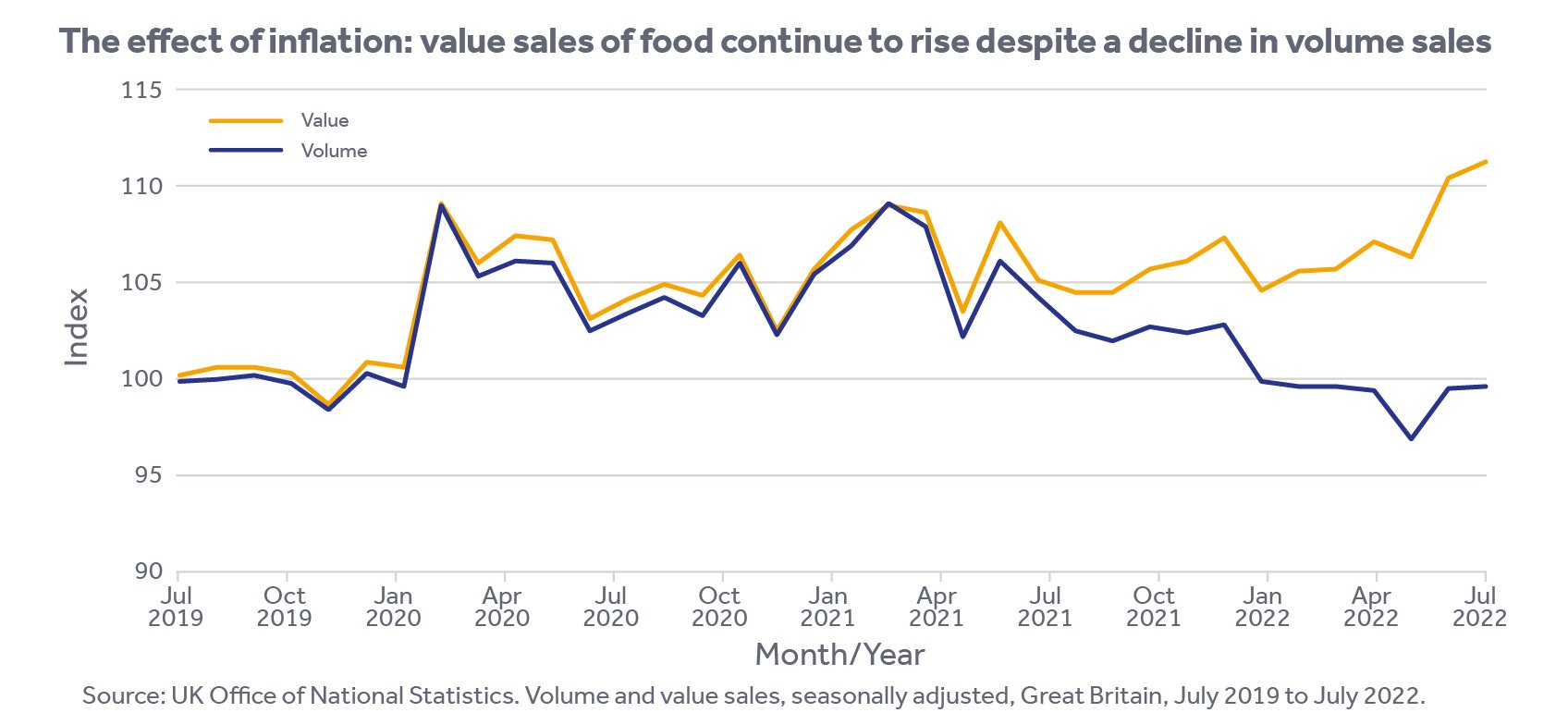
Nor is inflation an accurate guide to how much people are spending. With energy costs soaring, consumers will cut back on other products or services. For example, if haircuts go up 30%, customers may space out their salon visits, but prices won’t necessarily come down.
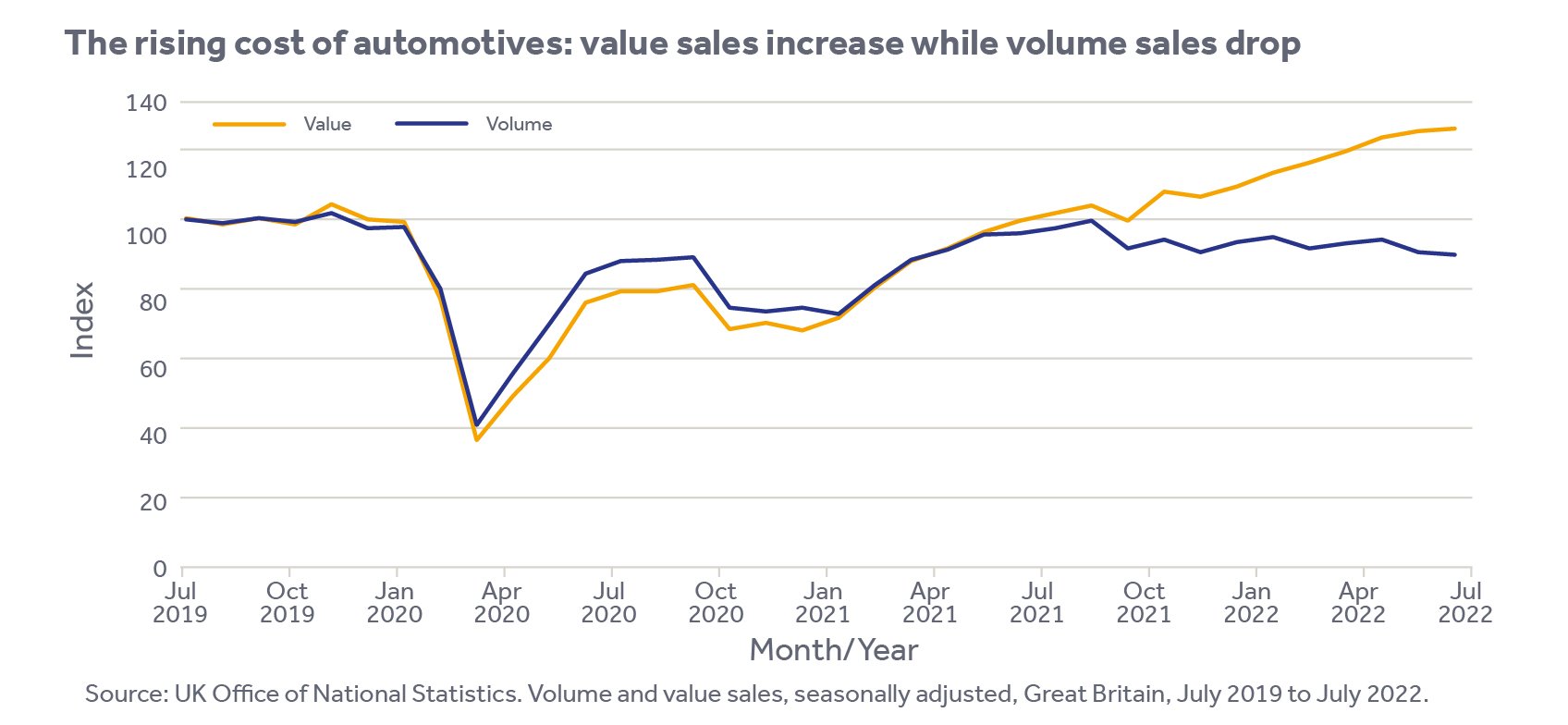
How does the inflation outlook in the UK compare with other countries?
Let’s take Germany and the US as examples.
If we look at Germany, the UK should logically see higher inflation, as we import half of our food, overwhelmingly from the EU, with tariffs and red tape adding costs to those imports. Also, the UK uses more natural gas than Europe in its energy mix.
In the US, inflation is key for investors, as the US Federal Reserve (Fed) drives global interest rates and therefore impacts inflation in the rest of the world.
Inflation in the US could be sticky, as it has had time to spread throughout the economy, particularly into services and rents. This is less the case in Europe, where energy and food are still behind the bulk of price increases.
Wages are the long-term inflation setters. Here, the UK experience is worse than the US. In the US, decades of union weakness have made it difficult for the workforce to get pay settlements anywhere near inflation. In the UK, however, we are now seeing strikes from workers in areas such as transport, refuse collection, postal delivery, barristers, call centres and journalists, which bodes ill for wage restraint.
Does the US measure inflation in the same way as the UK?
The Fed’s inflation gauge is technically the core Personal Consumption Expenditures (PCE) Price Index excluding energy and food (this is a measure of consumer spending used to track the price of goods over time), currently at 4.6%, rather than the headline Consumer Price Index (CPI) (which tracks consumer prices by measuring the average cost of a ‘basket’ of goods and services on a monthly basis) at 8.3%. It is hard to believe, however, that the Fed would not acknowledge consumer pain, and focus on bringing down the headline CPI before declaring victory on inflation.
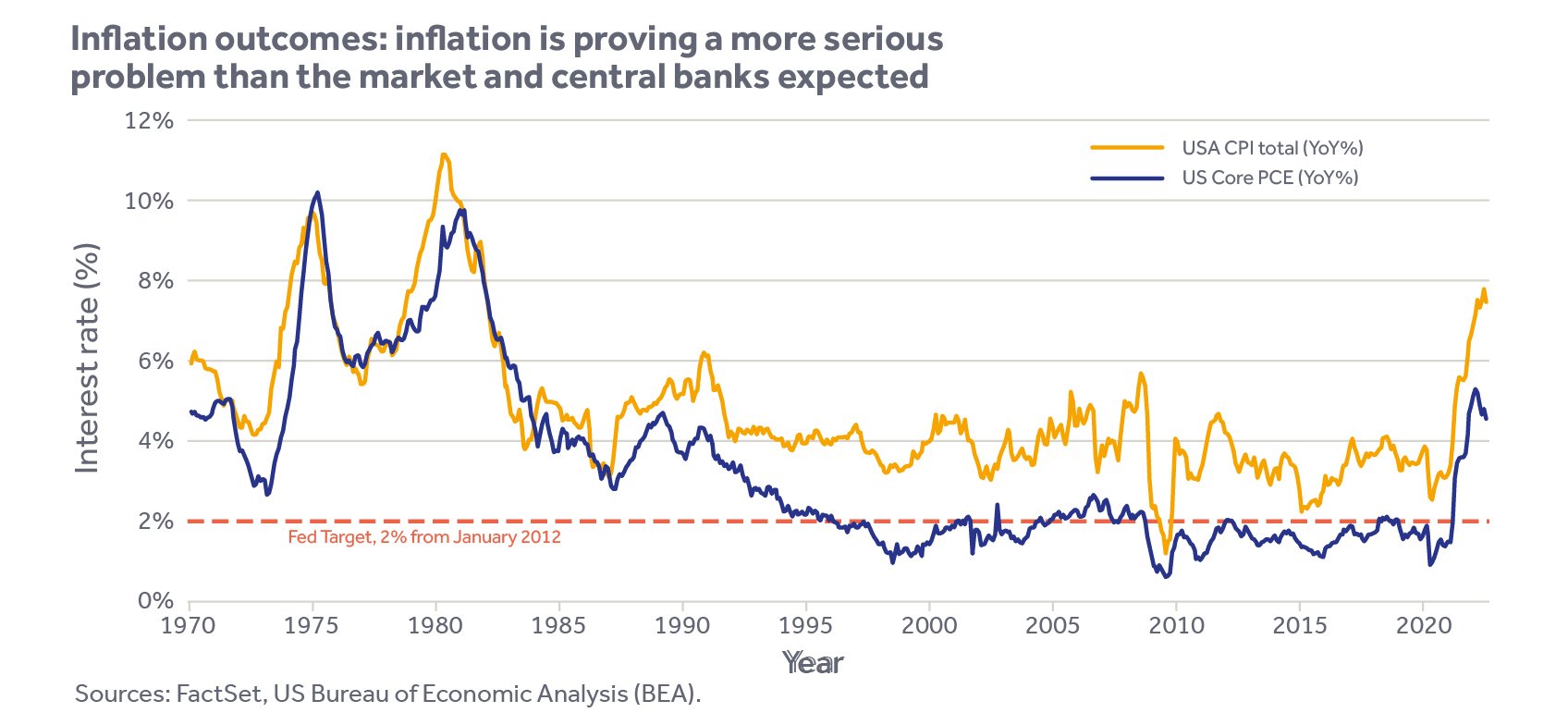
Which products or services have contributed the most to the rise in inflation?
Looking at the US and Germany highlights the issues, with the UK somewhere in the middle.
In the US, headline CPI is 8.3%, with core inflation (excluding food and energy) at 6.3%, whereas in Germany headline is 8.8% and core 3.5%. The majority of German inflation is driven by energy; in particular natural gas prices. In the US, inflation has spread to other expenditures. This is because the root cause of inflation in the US has been the massive COVID-19 subsidies sent to households in 2020 and 2021 (near US$2trn), allowing consumers to shop like crazy during lockdowns.
The UK lies somewhere in between. Core CPI (excluding energy, food, alcohol and tobacco) is 6.3% out of 9.9% headline CPI. Contagion from energy and food prices into total goods is significant and also starting to impact services.
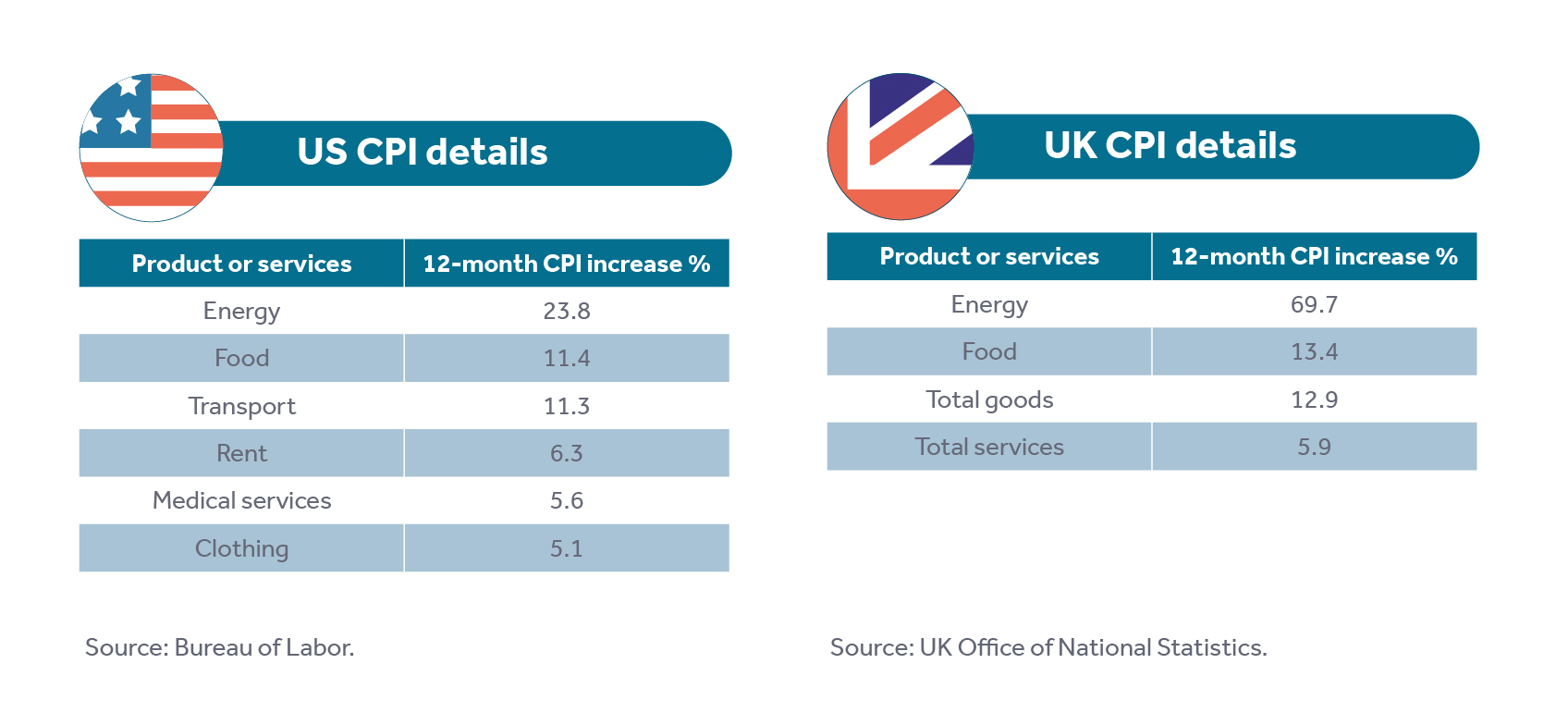
So what is the outlook for inflation?
The US has probably seen the peak of inflation, but it may still lie ahead for the UK and Europe. Many investors think that the June 9.1% US CPI was the peak, whereas we might have to wait until early next year to see the peak on our side of the pond.
This is the wrong debate, though. What matters is how fast and far inflation levels come down.
Central banks are under the cosh and need to get inflation under control, lest their independence should be under threat. This should mean it is only a matter of time before inflation abates to more reasonable levels, although a recession might be needed.
If the increase was ‘transitory’, the rise and fall should be symmetrical; so to understand how inflation could fall, we should look at how it has risen. By comparing monthly Consumer Price Index (CPI) readings in the US with annual data, you can see how the numbers have surged. Once low monthly data (up to January 2021) fell out of the series, it was easy to reach 7-9% in annualised CPI. Conversely, for annual inflation to come down meaningfully, we are likely to have to wait for June 2023, when the high monthly readings at the beginning of 2022 fall off the 12-month numbers.
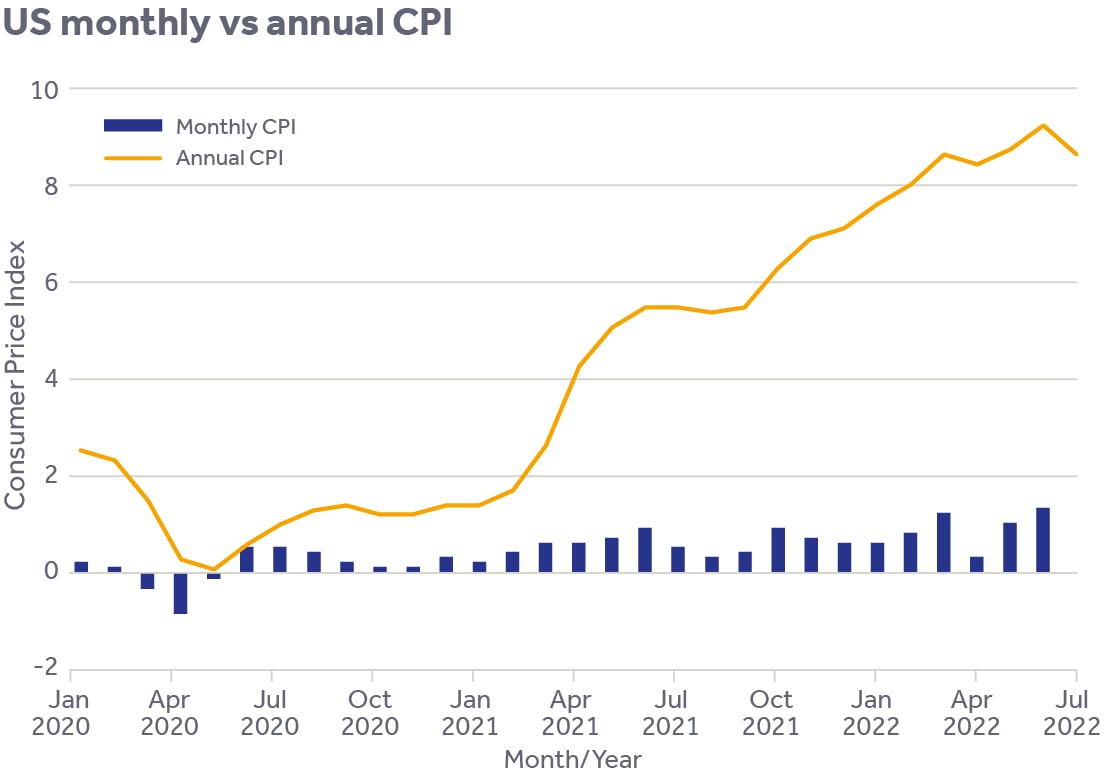
Assuming this, US CPI would be back down to the 2% area in Q4 2023. The current spike in the UK has taken exactly one year to move from the 2% level, so, if price rises reach their peak in six months, we could conceivably see 2% UK inflation again in mid-2024 – almost two years away – although the Chancellor’s tax cuts and spending plans may affect that timeline.
Where is inflation likely to settle in the long run?
Two opposing factors will influence inflation in the long term.
First, demographics: births in developed countries are now almost systematically below the replacement level of 2.1 children per woman. Long-term inflation is correlated with population growth, with Japan at the low end and African countries at the upper end.
Secondly, and conversely, COVID-19 has accelerated retirements and driven some people back into education or into leaving the country. The result is a much tighter jobs market, which feeds into higher prices.
In the long run, though, high inflation has generally been tied to exceptional events, such as world wars and the creation of the welfare state. Otherwise, steady-state price rises tend to be closer to the 2% central bank target.
Is 2% an acceptable inflation level?
It is possible that central banks will reconsider their inflation targets. The 2% objective does not have much scientific backing and could easily be amended to 2.5% or 3%. Being less dogmatic about inflation could spare the world a damaging economic downturn.
How do you invest to try to beat inflation?
Investment returns this year have been quite instructive as to what works and what doesn’t in a high inflation environment.
- On the positive side (or less negative): energy, materials and defensive sectors (utilities, infrastructure, consumer staples); geographically, markets with high exposure to these areas (FTSE 100, Canada, Australia, Mexico, Brazil)
- On the negative side: technology and other growth sectors, notably companies with future rather than current profits; countries exposed to the Ukraine war fallout (Europe).
In addition to the above, Asian equities are likely to be more resilient. Indeed, some markets in the region (China, for example) have emerged from a long bear market and others (such as Japan) have low relative valuations. Renewable energy should also enjoy a tailwind as it complements traditional energy.
Rising and then falling inflation could play havoc with a concentrated portfolio, with some sectors see-sawing sharply against the price backdrop. We believe that portfolios that incorporate a balance of cyclical and defensive sectors with inexpensive valuations are well positioned to combat the effects of inflation. Our focus will remain on actively managing our investors’ portfolios, and investing to try to beat inflation.
To discuss how our investment experts can actively manage your portfolio with the aim of beating inflation, please get in touch for a complimentary initial consultation with an Investment Manager.
You may also be interested in:
- Cautious investment portfolios in volatile times
- Clean energy investments - why we need more climate optimism
- Wealth succession planning
If you want to find out more, get in touch...
If you want to find out more about wealth management and learn how this can benefit you, we can put you in touch with our team of experts that can help.
Investment involves risk. The value of investments and the income from them can go down as well as up and you may not get back the amount originally invested. Past performance is not a reliable indicator of future performance.
The information provided is not to be treated as specific advice. It has no regard for the specific investment objectives, financial situation or needs of any specific person or entity.
This is not a recommendation to invest or disinvest in any of the companies, themes or sectors mentioned. They are included for illustrative purposes only.
The information contained herein is based on materials and sources deemed to be reliable; however, Adam & Company makes no representation or warranty, either express or implied, to the accuracy, completeness or reliability of this information. All stated opinions and estimates in this document are subject to change without notice and Adam & Company is under no obligation to update the information.
Find this information useful? Share it with others...
Investment involves risk and you may not get back what you invest. It’s not suitable for everyone.
Investment involves risk and is not suitable for everyone.
